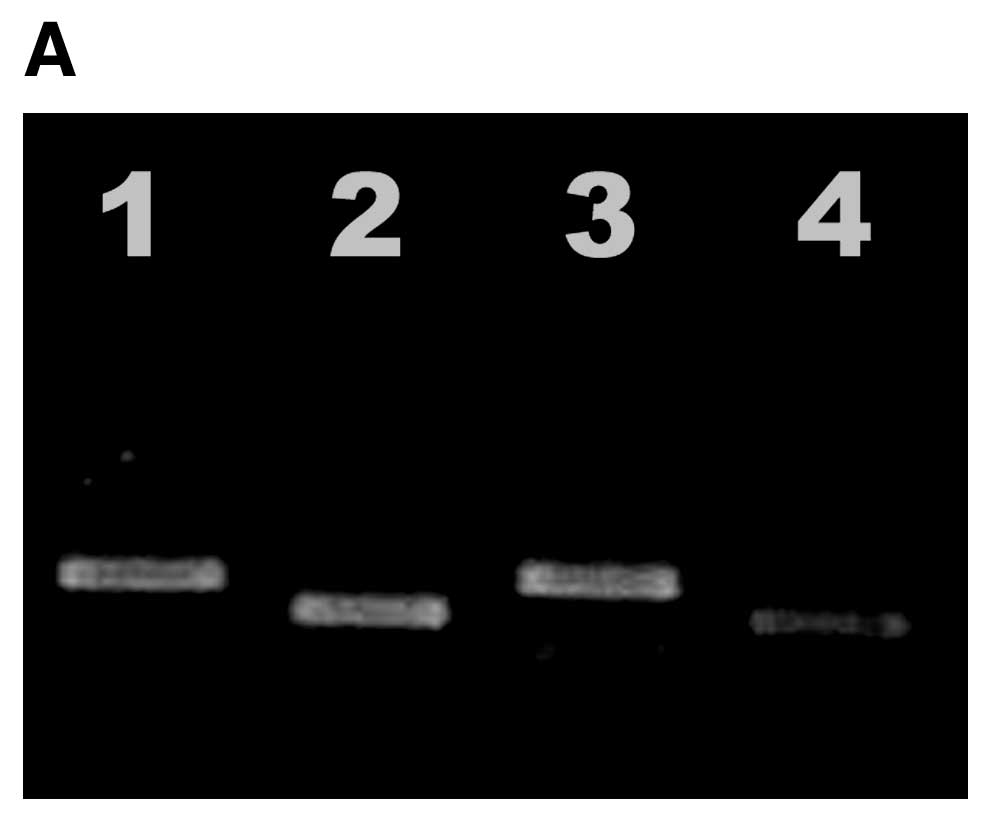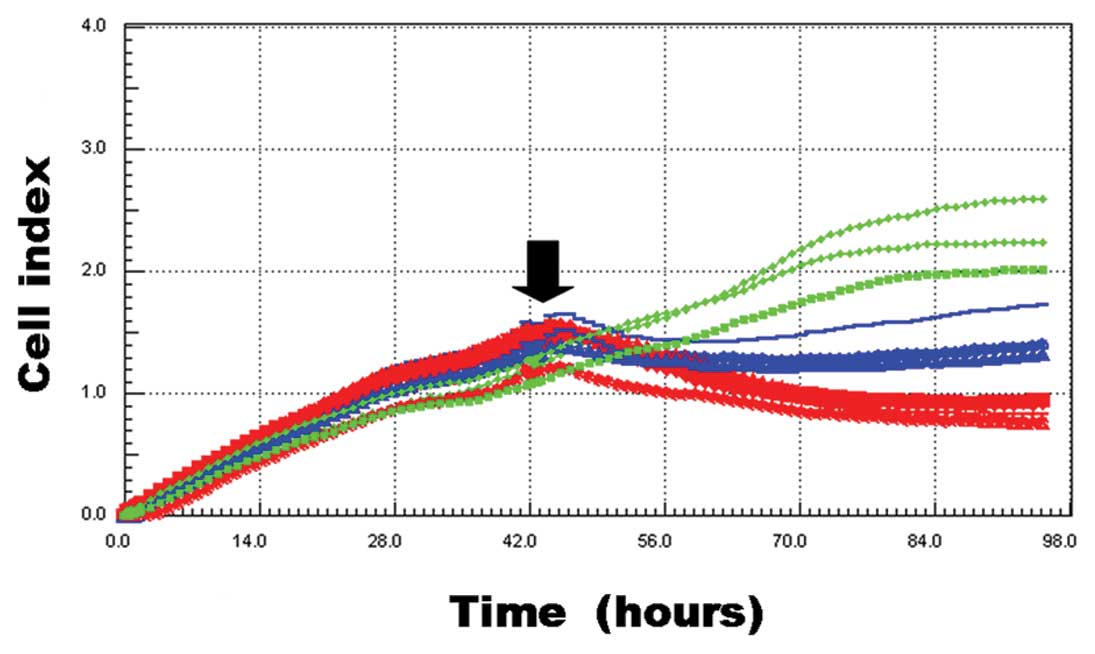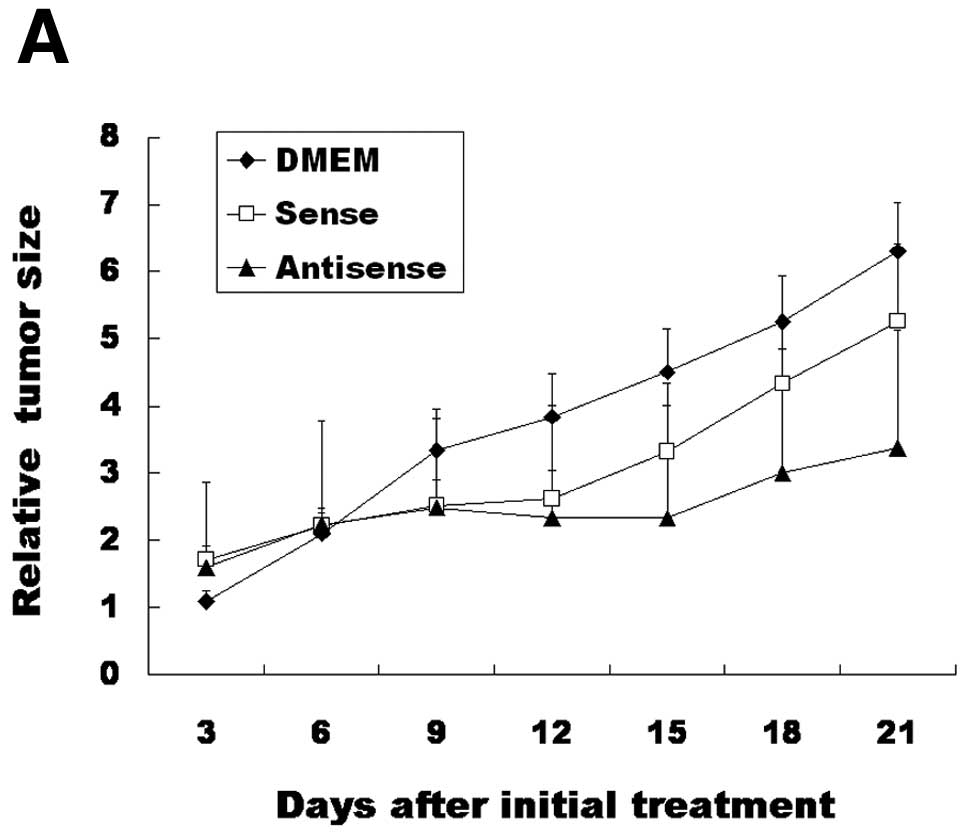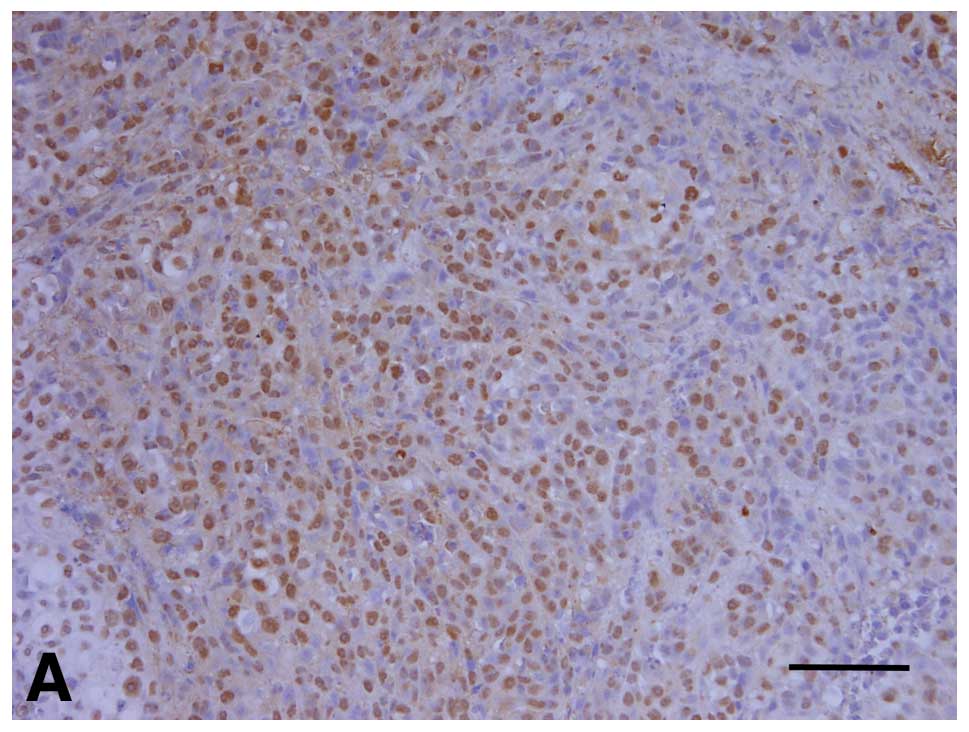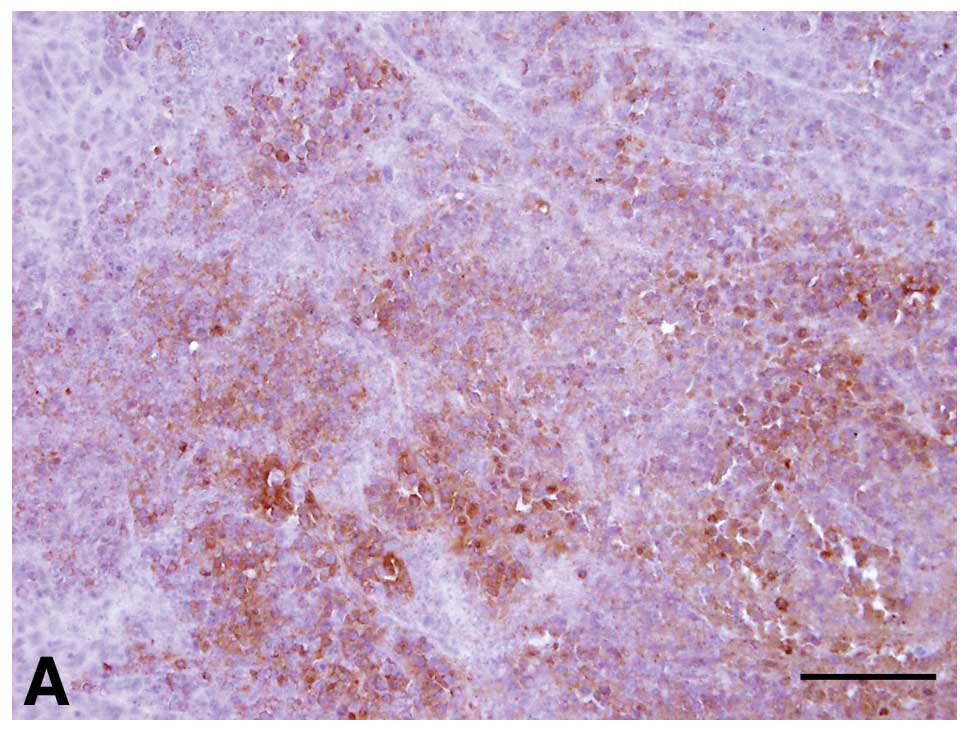|
1
|
Kim ES, Kies M and Herbst RS: Novel
therapeutics for head and neck cancer. Curr Opin Oncol. 14:334–342.
2002. View Article : Google Scholar : PubMed/NCBI
|
|
2
|
Hong SD, Hong SP, Lee JI and Lim CY:
Expression of matrix metalloproteinase-2 and -9 in oral squamous
cell carcinomas with regard to the metastatic potential. Oral
Oncol. 36:207–213. 2000. View Article : Google Scholar : PubMed/NCBI
|
|
3
|
Lionetti P, Pazzaglia A, Moriondo M, et
al: Differing patterns of transforming growth factor-β expression
in normal intestinal mucosa and in active celiac disease. J Pediatr
Gastroenterol Nutr. 29:308–313. 1999.
|
|
4
|
Ellenrieder V, Hendler SF, Ruhland C,
Boeck W, Adler G and Gress TM: TGF-β-induced invasiveness of
pancreatic cancer cells is mediated by matrix metalloproteinase-2
and the urokinase plasminogen activator system. Int J Cancer.
93:204–211. 2001.
|
|
5
|
Sier CFM, Kubben FJGM, Ganesh S, et al:
Tissue level of matrix metalloproteinases MMP-2 and MMP-9 are
related to the overall survival of patients with gastric carcinoma.
Br J Cancer. 74:413–417. 1996. View Article : Google Scholar : PubMed/NCBI
|
|
6
|
Wakefield LM and Roberts AB: TGF-β
signaling: positive and negative effects on tumorigenesis. Curr
Opin Genet Dev. 12:22–29. 2002.
|
|
7
|
Thiery JP: Epithelial-mesenchymal
transitions in tumour progression. Nat Rev Cancer. 2:442–454. 2002.
View Article : Google Scholar : PubMed/NCBI
|
|
8
|
Kovasc EJ: Fibrogenic cytokines: The role
of immune mediators in the development of scar tissue. Immunol
Today. 12:17–23. 1991. View Article : Google Scholar : PubMed/NCBI
|
|
9
|
Stetler-Stevenson WG, Aznavoorian S and
Liotta LA: Tumor cell interactions with the extracellular matrix
during invasion and metastasis. Annu Rev Cell Biol. 9:541–573.
1993. View Article : Google Scholar : PubMed/NCBI
|
|
10
|
Nagase H and Woessner JF Jr: Matrix
metalloproteinases. J Biol Chem. 274:21491–21494. 1999. View Article : Google Scholar
|
|
11
|
Kim SG, Kim MH, Chae CH, Jung YK and Choi
JY: Downregulation of matrix metalloproteinases in hyperplastic
dental follicles results in abnormal tooth eruption. BMB Rep.
41:322–327. 2008. View Article : Google Scholar : PubMed/NCBI
|
|
12
|
Kim JY, Rotaru H and Kim SG: The clinical
significance of the expression of TGF-β1 and MMP-2 related to the
regional lymph node metastasis in the oral squamous cell carcinoma.
J Korean Oral Maxillofac Surg. 33:199–203. 2007.
|
|
13
|
Park YW, Kim SG, Choi JY and Lee SK:
Recapitulating orthotopic tumor model through establishment of a
parotid gland tumor with lung metastasis using HeLa cell injection
into nude mice. Oncol Rep. 23:701–708. 2010.PubMed/NCBI
|
|
14
|
Carlsson G, Gullberg B and Hafström L:
Estimation of liver tumor volume using different formulas - an
experimental study in rats. J Cancer Res Clin Oncol. 105:20–23.
1983.PubMed/NCBI
|
|
15
|
Roberts AB and Sporn MB: The transforming
growth factors. Peptide Growth Factors and their Receptors I. Sporn
MB and Roberts AB: Springer; Berlin: pp. 419–472. 1990, View Article : Google Scholar
|
|
16
|
Prime SS, Matthews JB, Patel V, et al:
TGF-β receptor regulation mediates the response to exogenous ligand
but is independent of the degree of cellular differentiation in
human oral keratinocytes. Int J Cancer. 56:406–412. 1994.
|
|
17
|
Aiping H: Drug resistance and gene
amplification potential regulated by transforming growth factor β1
gene expression. Cancer Res. 55:1758–1762. 1995.PubMed/NCBI
|
|
18
|
Yingling JM, Blanchard KL and Sawyer JS:
Development of TGF-β signaling inhibitors for cancer therapy. Nat
Rev Drug Discov. 3:1011–1022. 2004.
|
|
19
|
Moore LD, Isayeva T, Siegal GP and
Ponnazhagan S: Clin Cancer Res. 14:4961–4970. 2008. View Article : Google Scholar
|
|
20
|
Woolf TM, Melton DA and Jennings CGB:
Specificity of an antisense oligonucleotides in vivo. Proc Natl
Acad Sci USA. 89:7305–7309. 1992. View Article : Google Scholar : PubMed/NCBI
|
|
21
|
Thierry AR, Rahman A and Dritschilo A:
Liposomal delivery as a new approach to transport antisense
oligonucleotides. Gene Regulation: Biology of Antisense RNA and
DNA. Erickson R and Izant JF: Raven Press Ltd; New York: pp.
147–161. 1992
|
|
22
|
Cheng K, Yang N and Mahato RI: TGF-β1 gene
silencing for treating liver fibrosis. Mol Pharm. 6:772–779.
2009.
|
|
23
|
Wilkins-Port CE and Higgins PJ: Regulation
of extracellular matrix remodeling following transforming growth
factor-beta1/epidermal growth factor-stimulated
epithelial-mesenchymal transition in human premalignant
keratinocytes. Cells Tissues Organs. 185:116–122. 2007. View Article : Google Scholar
|
|
24
|
Dasgupta S, Bhattacharya-Chatterjee M,
O’Malley BW Jr and Chatterjee SK: Tumor metastasis is an orthotopic
murine model of head and neck cancer: possible role of TGF-beta 1
secreted by the tumor cells. J Cell Biochem. 97:1036–1051. 2006.
View Article : Google Scholar : PubMed/NCBI
|
|
25
|
Sun L, Diamond ME, Ottaviano AJ, Joseph
MJ, Ananthanarayan V and Munshi HG: Transforming growth factor-β1
promotes matrix metalloproteinase-9-mediated oral cancer invasion
through Snail expression. Mol Cancer Res. 6:10–20. 2008.
|
|
26
|
Munshi HG, Wu YI, Mukhopadhyay S, et al:
Differential regulation of membrane type 1-matrix metalloproteinase
activity by ERK 1/2- and p38 MAPK-modulated tissue inhibitor of
metalloproteinases 2 expression controls transforming growth
factor-beta 1-induced pericellular collagenolysis. J Biol Chem.
279:39042–39050. 2004. View Article : Google Scholar
|















